A Compact Multiple Notched Ultra-Wide Band Antenna with an Analysis of the CSRR-TO-CSRR Coupling for Portable UWB Applications
Abstract
:1. Introduction
2. Design and Simulation Results
2.1. VSWR (Reflection Coefficient) and Antenna Gain (Radiation Efficiency)
2.2. Notched Frequency Control
3. Analysis of Quad-Notched Antenna with CSRR-TO-CSRR Coupling
3.1. Calculation of the Coupling Coefficients
3.2. Equivalent Lumped Element Circuit
4. Time Domain Behavior of the Proposed Antenna
5. Measurements
6. Comparison with Recently Proposed Designs
7. Conclusions
Acknowledgments
Author Contributions
Conflicts of Interest
References
- Abbas, S.M.; Ranga, Y.; Verma, A.K.; Esselle, K.P. A simple ultra-wideband printed monopole antenna with high band rejection and wide radiation patterns. IEEE Trans. Antennas Propag. 2014, 62, 4816–4820. [Google Scholar] [CrossRef]
- Ojaroudi, N.; Ghadimi, N. Omnidirectional microstrip monopole antenna design for use in microwave imaging systems. Microw. Opt. Technol. Lett. 2015, 57, 395–401. [Google Scholar] [CrossRef]
- Islam, M.T.; Islam, M.M.; Samsuzzaman, M.; Faruque, M.R.I.; Misran, N. A negative index metamaterial-inspired UWB antenna with an integration of complementary SRR and CLS unit cells for microwave imaging sensor applications. Sensors 2015, 15, 11601–11627. [Google Scholar] [CrossRef] [PubMed]
- Maaref, N.; Millot, P.; Pichot, C.; Picon, O. A study of UWB FM-CW radar for the detection of human beings in motion inside a building. IEEE Trans. Geosci. Remote Sens. 2009, 47, 1297–1300. [Google Scholar] [CrossRef]
- Yan, J.; Hong, H.; Zhao, H.; Li, Y.; Gu, C.; Zhu, X. Through-wall multiple targets vital signs tracking based on VMD algorithm. Sensors 2016, 16, 1293. [Google Scholar] [CrossRef] [PubMed]
- Bernardi, P.; Cicchetti, R.; Pisa, S.; Pittella, E.; Piuzzi, E.; Testa, O. Design, realization, and test of a UWB radar sensor for breath activity monitoring. IEEE Sens. J. 2014, 14, 584–596. [Google Scholar] [CrossRef]
- Cicchetti, R.; Miozzi, E.; Testa, O. Wideband and UWB antennas for wireless applications: A comprehensive review. Int. J. Antennas Propag. 2017, 45. [Google Scholar] [CrossRef]
- Nguyen, T.D.; Lee, D.H.; Park, H.C. Design and analysis of compact printed triple band-notched UWB antenna. IEEE Antennas Wirel. Propag. Lett. 2011, 10, 403–406. [Google Scholar] [CrossRef]
- Jiang, D.; Xu, Y.; Xu, R.; Lin, W. Compact dual-band-notched UWB planar monopole antenna with modified CSRR. Electron. Lett. 2012, 48, 1250–1252. [Google Scholar] [CrossRef]
- Li, W.T.; Hei, Y.Q.; Feng, W.; Shi, X.W. Planar antenna for 3G/Bluetooth/WiMAX and UWB applications with dual band-notched characteristics. IEEE Antennas Wirel. Propag. Lett. 2012, 11, 61–64. [Google Scholar]
- Islam, M.T.; Azim, R.; Mobashsher, A.T. Triple band-notched planar UWB antenna using parasitic strips. Prog. Electromagn. Res. 2012, 129, 161–179. [Google Scholar] [CrossRef]
- Lin, C.C.; Jin, P.; Ziolkowski, R.W. Single, dual and tri band-notched ultrawideband (UWB) antennas using capacitively loaded loop (CLL) resonators. IEEE Trans. Antennas Propag. 2012, 60, 102–109. [Google Scholar] [CrossRef]
- Almalkawi, M.J.; Devabhaktuni, V.-K. Quad band-notched UWB antenna compatible with WiMAX/INSAT/lower/upper-WLAN applications. Electron. Lett. 2011, 47, 1062–1063. [Google Scholar] [CrossRef]
- Derneryd, A. Analysis of the microstrip disk antenna element. IEEE Trans. Antennas Propag. 1979, 27, 660–664. [Google Scholar] [CrossRef]
- Zhang, Y.; Hong, W.; Yu, C.; Kuai, Z.Q.; Don, Y.D.; Zhou, J.Y. Planar ultrawideband antennas with multiple notched bands based on etched slots on the patch and/or split ring resonators on the feed line. IEEE Trans. Antennas Propag. 2008, 56, 3063–3068. [Google Scholar] [CrossRef]
- Siddiqui, J.Y.; Saha, C.; Antar, Y.M. Compact SRR loaded UWB circular monopole antenna with frequency notch characteristics. IEEE Trans. Antennas Propag. 2014, 62, 4015–4020. [Google Scholar] [CrossRef]
- Falcone, F.; Lopetegi, T.; Laso, M.A.G.; Baena, J.D.; Bonache, J.; Beruete, M.; Sorolla, M. Babinet principle applied to the design of metasurfaces and metamaterials. Phys. Rev. Lett. 2004, 93, 197401. [Google Scholar] [CrossRef] [PubMed]
- Pozar, D.M. Microwave Engineering, 2nd ed.; Wiley: New York, NY, USA, 1998. [Google Scholar]
- Kim, H.; Park, D.; Joo, Y. All-digital low-power CMOS pulse generator for UWB system. Electron. Lett. 2004, 40, 1534–1535. [Google Scholar] [CrossRef]
- Jahromi, M.N.; Falahati, A.; Edwards, R.M. Application of fractal binary tree slot to design and construct a dual band-notch CPW-ground-fed ultra-wide band antenna. IET Microw. Antennas Propag. 2011, 5, 1424–1430. [Google Scholar] [CrossRef]
- Kwon, D.H. Effect of antenna gain and group delay variations on pulse-preserving capabilities of ultra wideband antennas. IEEE Trans. Antennas Propag. 2006, 54, 2208–2215. [Google Scholar] [CrossRef]
- Ma, T.G.; Jeng, S.K. Planar miniature tapered-slot-fed annular slot antennas for ultrawide-band radios. IEEE Trans. Antennas Propag. 2005, 53, 1194–1202. [Google Scholar]
- Reddy, G.S.; Mishra, S.K.; Kharche, S.; Mukherjee, J. High gain and low cross-polar compact printed elliptical monopole UWB antenna loaded with partial ground and parasitic patches. Prog. Electromagn. Res. B 2012, 43, 151–167. [Google Scholar] [CrossRef]
- Azim, R.; Islam, M.-T. Compact planar UWB antenna with band notch characteristics for WLAN and DSRC. Prog. Electromagn. Res. 2013, 133, 391–406. [Google Scholar] [CrossRef]
- Li, G.; Zhai, H.; Li, T.; Ma, X.Y.; Liang, C.H. Design of a compact UWB antenna integrated with GSM/WCDMA/WLAN bands. Prog. Electromagn. Res. 2013, 136, 409–419. [Google Scholar] [CrossRef]
- Liu, X.L.; Yin, Y.Z.; Liu, P.A.; Wang, J.H.; Xu, B. A CPW-fed dual band-notched UWB antenna with a pair of bended dual-L-shape parasitic branches. Prog. Electromagn. Res. 2013, 136, 623–634. [Google Scholar] [CrossRef]
- Fallahi, R.; Kalteh, A.A.; Roozbahani, M.G. A novel UWB elliptical slot antenna with band-notched characteristics. Prog. Electromagn. Res. 2008, 82, 127–136. [Google Scholar] [CrossRef]
- Peng, L.; Ruan, C.L. Design and time-domain analysis of compact multi-band-notched UWB antennas with EBG structures. Prog. Electromagn. Res. B 2013, 47, 339–357. [Google Scholar] [CrossRef]
- Li, Y.; Yang, X.D.; Liu, C.Y.; Jiang, T. Analysis and investigation of a cantor set fractal UWB antenna with a notch-band characteristic. Prog. Electromagn. Res. B 2011, 33, 99–114. [Google Scholar] [CrossRef]
- Gong, X.; Tong, L.; Tian, Y.; Gao, B. Design of a microstrip-fed hexagonal shape uwb antenna with triple notched bands. Prog. Electromagn. Res. C 2016, 62, 77–87. [Google Scholar] [CrossRef]
- Wang, S. A new compact printed triple band-notched UWB antenna. Prog. Electromagn. Res. Lett. 2016, 58, 67–72. [Google Scholar] [CrossRef]
- Mohammed, H.J.; Abdullah, A.S.; Ali, R.S.; Abd-Alhameed, R.A.; Abdulraheem, Y.I.; Noras, J.M. Design of a uniplanar printed triple band-rejected ultra-wideband antenna using particle swarm optimisation and the firefly algorithm. IET Microw. Antennas Propag. 2014, 10, 31–37. [Google Scholar] [CrossRef]
- Kim, D.O.; Jo, N.I.; Jang, H.A.; Kim, C.Y. Design of the ultrawideband antenna with quadruple-band rejection characteristics using a combination of the complementary split ring resonators. Prog. Electromagn. Res. 2011, 112, 93–107. [Google Scholar] [CrossRef]
- Ding, J.; Lin, Z.; Ying, Z.; He, S. A compact ultra-wideband slot antenna with multiple notch frequency bands. Microw. Opt. Technol. Lett. 2007, 49, 3056–3060. [Google Scholar] [CrossRef]
- Islam, M.M.; Islam, M.T.; Faruque, M.R.I. A parametric study of compact UWB antenna with multiple notched-band functions. In Advances in Machine Learning and Signal Processing; Springer: Berlin/Heidelberg, Germany, 2016; pp. 155–162. [Google Scholar]
- Anagnostou, D.E.; Chryssomallis, M.T.; Braaten, B.D.; Ebel, J.L.; Sepúlveda, N. Reconfigurable UWB antenna with RF-MEMS for on-demand WLAN rejection. IEEE Trans. Antennas Propag. 2014, 62, 602–608. [Google Scholar] [CrossRef]


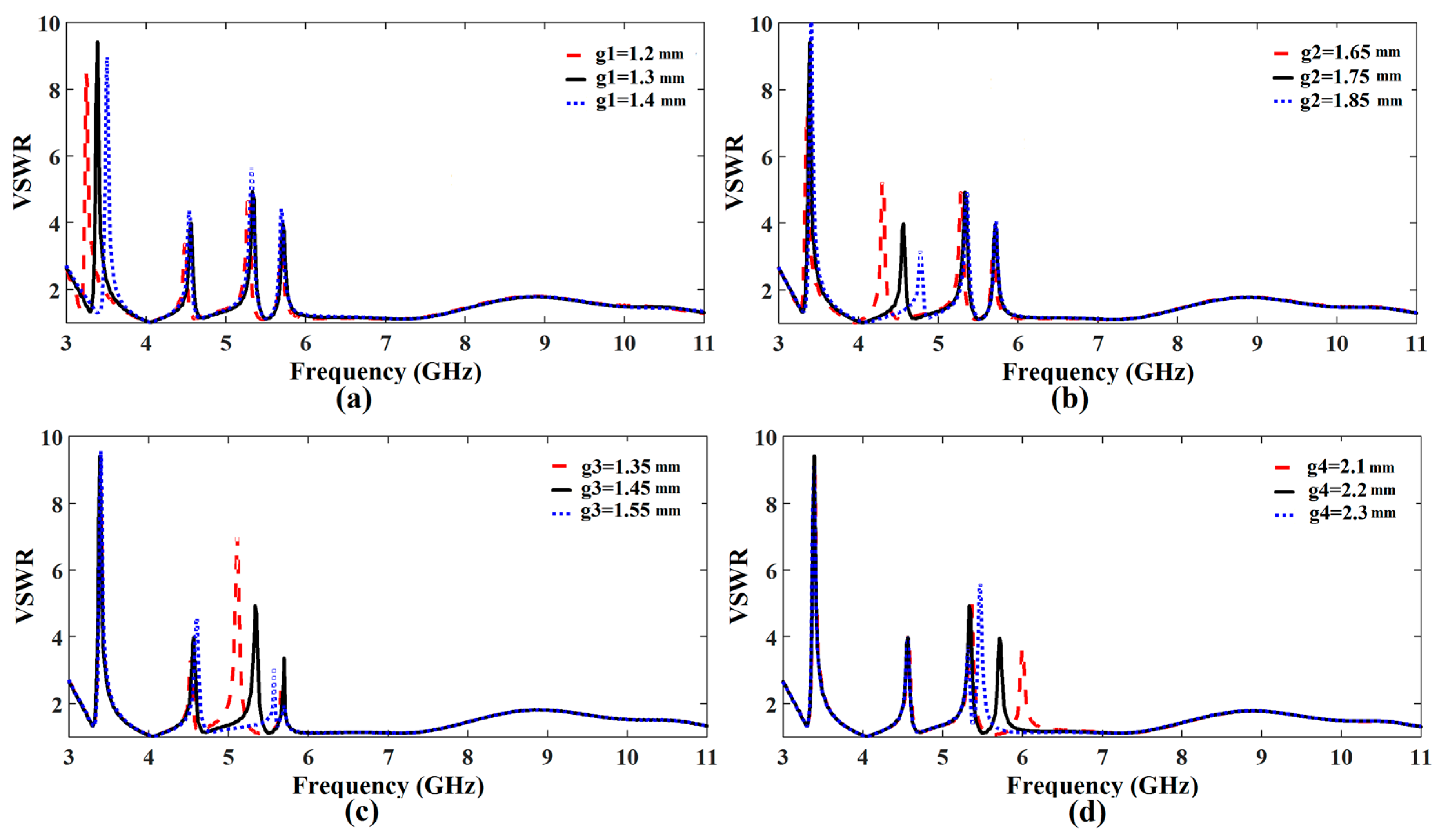
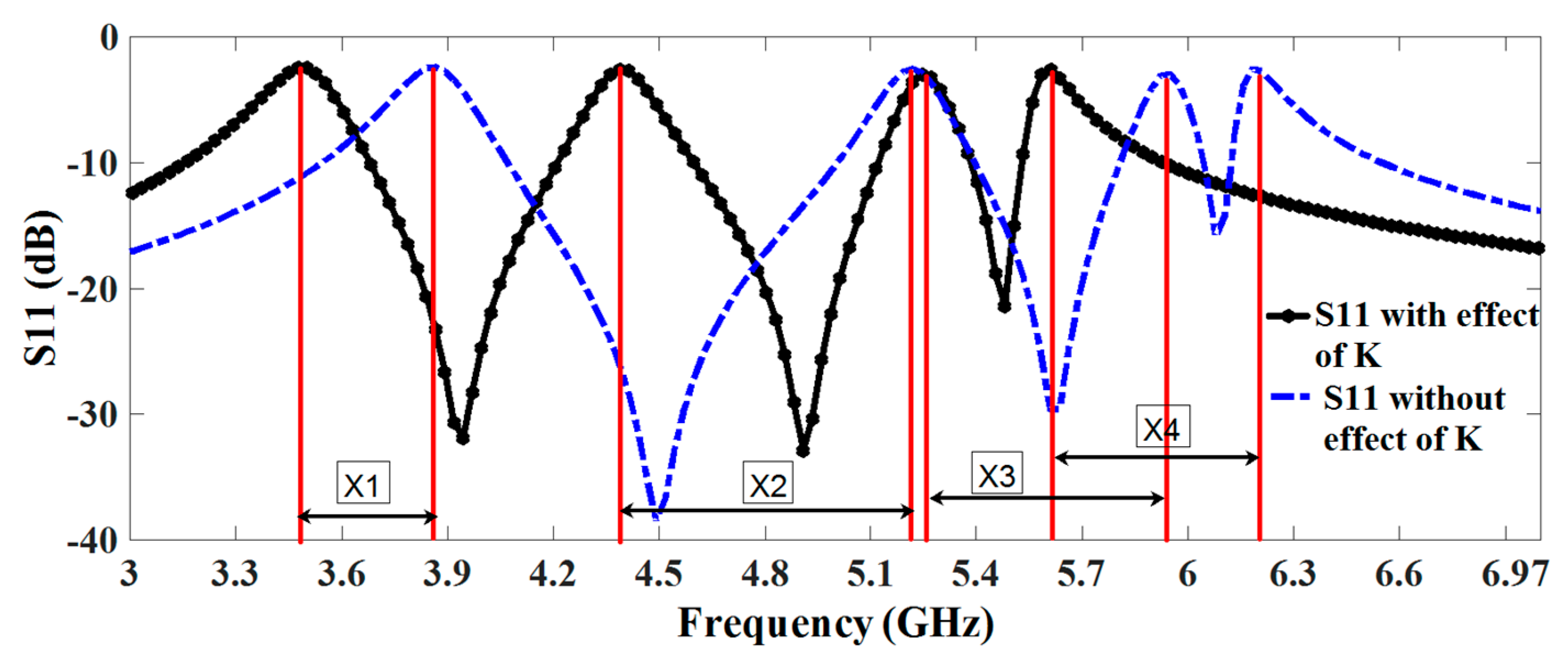
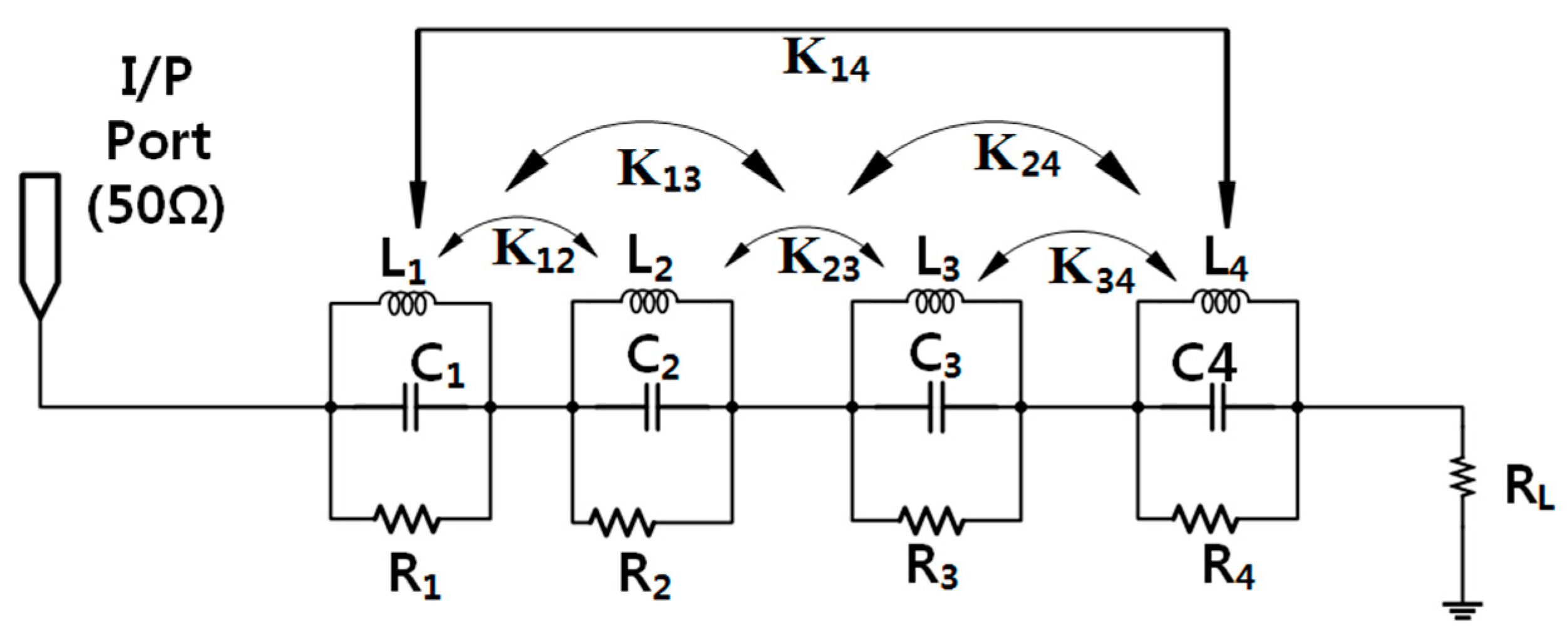

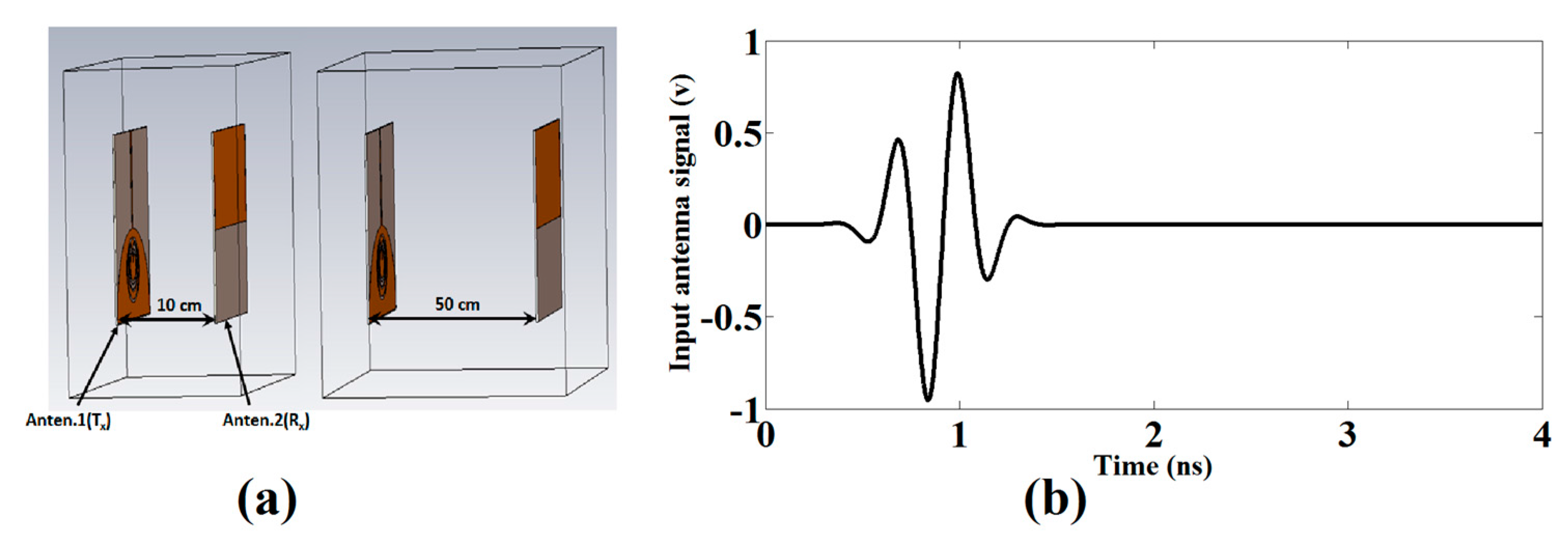

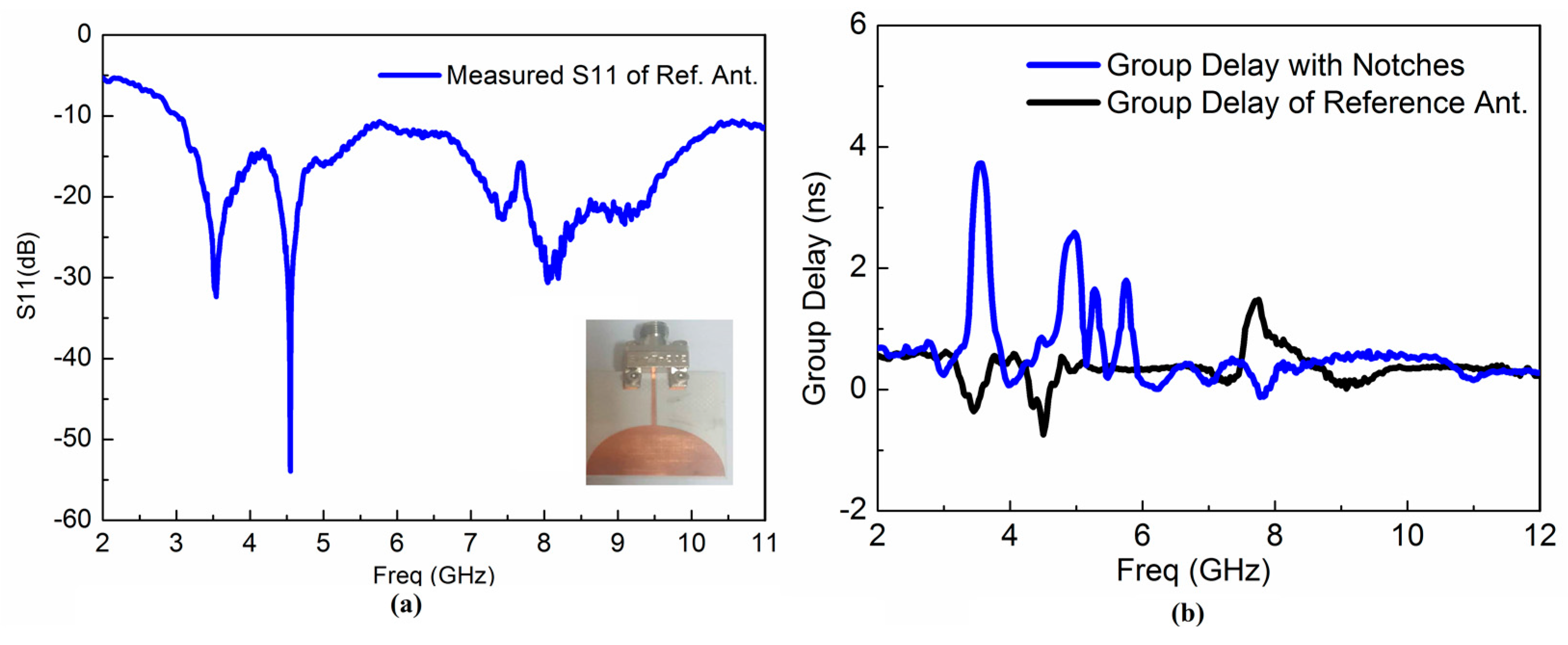
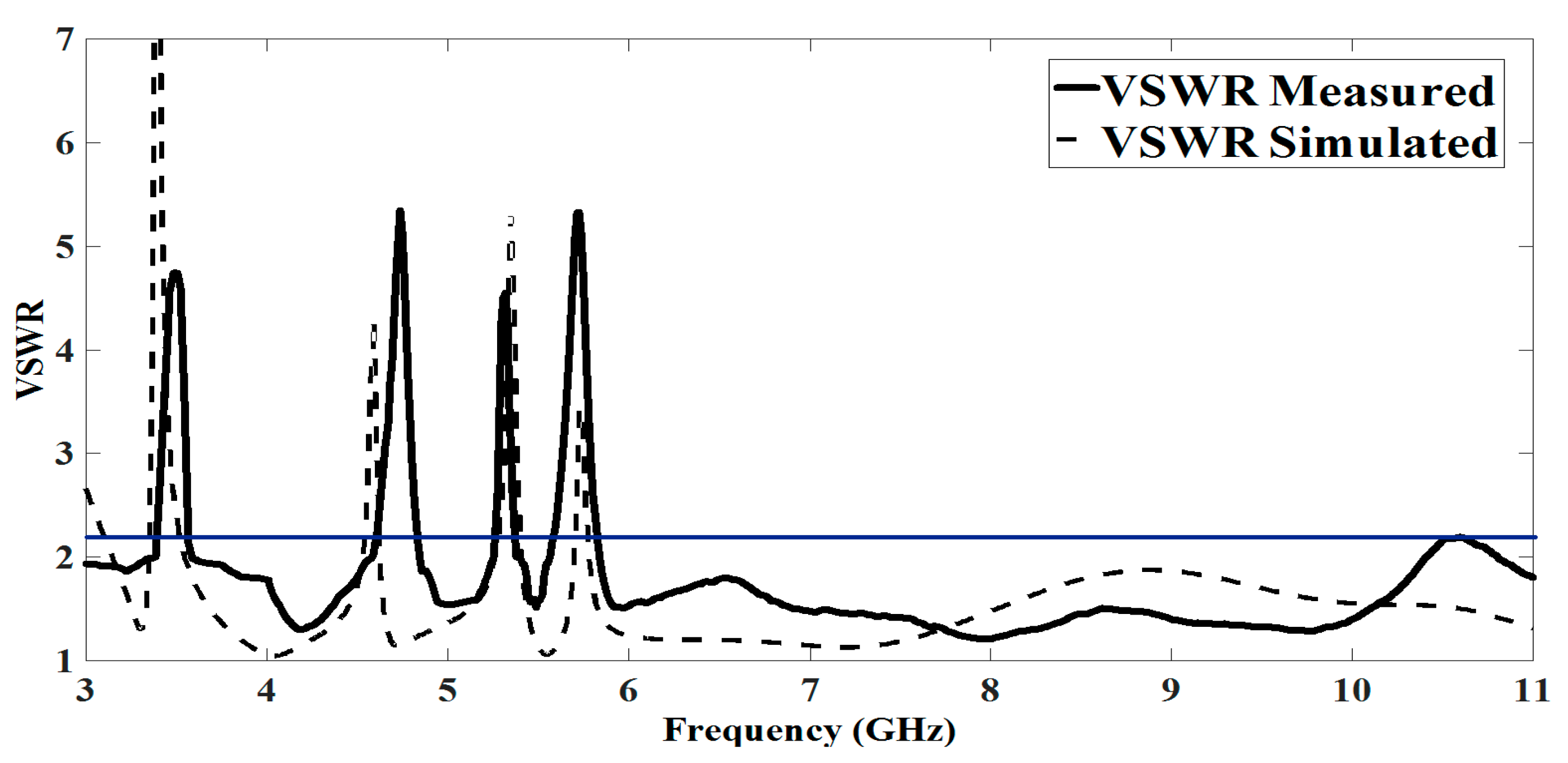

| Parameter | Value (mm) | Parameter | Value (mm) |
|---|---|---|---|
| Lsub | 30 | Lgnd | 15.3 |
| Wsub | 28 | Lf | 15.5 |
| Wf | 1 | R1 | 2.3 |
| R2 | 2.5 | R3 | 3.8 |
| R4 | 5.2 | g1 | 1.3 |
| g2 | 1.75 | g3 | 1.45 |
| g4 | 2.2 |
| f(WiMAX) | f(INSAT) | f(lower WLAN) | f(Upper WLAN) | |
|---|---|---|---|---|
| Predicted without coupling (f1) | 3.5 GHz | 4.5 GHz | 5.25 GHz | 5.65 GHz |
| Predicted with coupling (f2) | 3.85 GHz | 5.2 GHz | 5.95 GHz | 6.25 GHz |
| Difference (X = f2 − f1) | X1 = 0.35 GHz | X2 = 0.7 GHz | X3 = 0.7 GHz | X4 = 0.6 GHz |
| Circuit | BW (MHz) | Q0 | R (Ω) | L (pH) | C (pF) |
|---|---|---|---|---|---|
| 1 | 60 | 59.1 | 310 | 239.5 | 8.65 |
| 2 | 52 | 88.46 | 295 | 127.5 | 10.3 |
| 3 | 47 | 111.7 | 240 | 67.85 | 13.54 |
| 4 | 37 | 156.1 | 270 | 47.64 | 17 |
| Distance between Tx and Rx (cm) | Reference Antenna Stretch Ratio (SR) | Proposed Antenna Stretch Ratio (SR) | Reference Antenna Correlation Factor () | Proposed Antenna Correlation Factor () |
|---|---|---|---|---|
| 10 | 1.4 | 1.95 | 0.968 | 0.923 |
| 30 | 1.6 | 2.20 | 0.949 | 0.821 |
| 50 | 1.9 | 2.37 | 0.891 | 0.762 |
| Literature | Size (mm) | Filtering Bands (GHz) | Remarks |
|---|---|---|---|
| [23] | 28 × 24 | N/A | Antenna only operate in UWB range with no rejection bands |
| [24] | 26 × 24 | 5.1–5.9 | Antenna reject the complete WLAN band |
| [25] | 30 × 30 | 2.4 | Antenna rejects 2.4 GHz WLAN band |
| [26] | 40 × 30 | 3.3–3.7 5.15–5.825 | Antenna reject the complete WLAN and WiMAX band, Large size with complicated irregular structure |
| [27] | 45 × 50 | 5.1–5.825 | Rejects complete WLAN band with large dimensions |
| [28] | 22 × 32 | 4.97–5.28 5.66–5.92 | Dismiss the lower and upper WLAN bands, but the notching is not selective |
| [29] | 26 × 21 | 5.0–6.3 | Extra band rejection at the cost of size reduction |
| [30] | 40 × 31 | 3.31–3.78 5.33–5.77 7.24–7.72 | Increased rejection bands at the expense of size. Also, the notching is not selective and reject extra frequency bands |
| [31] | 40 × 20 | 2.75–3.15 5.15–5.35 7.25–8.39 | Inefficient WiMAX and downlink of X-band filtering |
| [32] | 30 × 28 | 5.15–5.825 3.3–3.76 7.25–7.745 | Antenna filtering is not selective at the desired bands and having complex structure |
| [33] | 40 × 20 | 2.37–2.39 3.27–3.76 5.2–5.89 8.06–8.80 | Quad notching without analyzing the coupling b/w CSRR Extra band-notching for WiMAX and X-band satellite communication while complete WLAN band-notching |
| [34] | 33 × 28 | 3.65 5.75 | Compact dimensions with multiple SRR and dual notched bands |
| [35] | 31 × 25 | 3.4–3.8 5.1–5.35 5.6–6.0 7.15–7.65 8.05–8.65 | Compact UWB multiple notched antenna using combination of different slot resonators |
| [36] | 4 × 4.4 cm2 | 5.15–5.825 | MEMS-based reconfigurable antenna with fine-tuning of the rejection band |
| This Work | 28 × 30 | 3.30–3.36 4.50–4.70 5.15–5.35 5.70–5.825 | Quad notching with simple structure, compact size, complete and selective filtering with proposed coupling analysis b/w CSRR |
© 2017 by the authors. Licensee MDPI, Basel, Switzerland. This article is an open access article distributed under the terms and conditions of the Creative Commons Attribution (CC BY) license (http://creativecommons.org/licenses/by/4.0/).
Share and Cite
Rahman, M.; Ko, D.-S.; Park, J.-D. A Compact Multiple Notched Ultra-Wide Band Antenna with an Analysis of the CSRR-TO-CSRR Coupling for Portable UWB Applications. Sensors 2017, 17, 2174. https://doi.org/10.3390/s17102174
Rahman M, Ko D-S, Park J-D. A Compact Multiple Notched Ultra-Wide Band Antenna with an Analysis of the CSRR-TO-CSRR Coupling for Portable UWB Applications. Sensors. 2017; 17(10):2174. https://doi.org/10.3390/s17102174
Chicago/Turabian StyleRahman, MuhibUr, Dong-Sik Ko, and Jung-Dong Park. 2017. "A Compact Multiple Notched Ultra-Wide Band Antenna with an Analysis of the CSRR-TO-CSRR Coupling for Portable UWB Applications" Sensors 17, no. 10: 2174. https://doi.org/10.3390/s17102174





